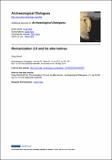Files in this item
Romanization 2.0 and its alternatives
Item metadata
| dc.contributor.author | Woolf, Greg | |
| dc.date.accessioned | 2015-05-31T23:10:53Z | |
| dc.date.available | 2015-05-31T23:10:53Z | |
| dc.date.issued | 2014-06 | |
| dc.identifier | 120047914 | |
| dc.identifier | 39d24b06-65b2-4b91-ad4e-4533574adbd9 | |
| dc.identifier | 84901008754 | |
| dc.identifier | 000336496400006 | |
| dc.identifier.citation | Woolf , G 2014 , ' Romanization 2.0 and its alternatives ' , Archaeological Dialogues , vol. 21 , no. 1 , pp. 45-50 . https://doi.org/10.1017/S1380203814000087 | en |
| dc.identifier.issn | 1380-2038 | |
| dc.identifier.uri | https://hdl.handle.net/10023/6716 | |
| dc.description.abstract | This essay argues that Romanization revolves around understanding objects in motion and that Roman archaeologists should therefore focus on (1) globalization theory and (2) material-culture studies as important theoretical directions for the (near) future. The present state and scope of the Romanization debate, however, seem to prevent a fruitful development in that direction. The first part of this paper therefore briefly analyses the Romanization debate and argues that large parts of ‘Anglo-Saxon Roman archaeology’ have never been really post-colonial, but in fact from the mid1990s onwards developed a theoretical position that should be characterized as anticolonial. This ideologically motivated development has resulted in several unhealthy divides within the field, as well as in an uncomfortable ending of the Romanization debate. The present consensus within English-speaking Roman archaeology ‘to do away with Romanization’ does not seem to get us at all ‘beyond Romans and Natives’, and, moreover, has effectively halted most of the discussion about how to understand and conceptualize ‘Rome’. The second part of the article presents two propositions outlining how to move forward: globalization theory and material-culture studies. Through this focus we will be able to better understand ‘Rome’ as (indicating) objects in motion and the human–thing entanglements resulting from a remarkable punctuation of connectivity. This focus is important as an alternative perspective to all existing narratives about Romanization because these remain fundamentally historical, in the sense that they reduce objects to expressions (of identity) alone. It is time for our discussions about ‘Rome’ to move ‘beyond representation’ and to become genuinely archaeological at last, by making material culture, with its agency and materiality, central to the analyses. | |
| dc.format.extent | 6 | |
| dc.format.extent | 493501 | |
| dc.language.iso | eng | |
| dc.relation.ispartof | Archaeological Dialogues | en |
| dc.rights | © Cambridge University Press 2014 | en |
| dc.subject | Romanization | en |
| dc.subject | Post-colonial Roman archaeology | en |
| dc.subject | Globalization | en |
| dc.subject | Material-culture studies | en |
| dc.subject | The object turn | en |
| dc.subject | Material agency | en |
| dc.subject | CC Archaeology | en |
| dc.subject | CB History of civilization | en |
| dc.subject | PA Classical philology | en |
| dc.subject.lcc | CC | en |
| dc.subject.lcc | CB | en |
| dc.subject.lcc | PA | en |
| dc.title | Romanization 2.0 and its alternatives | en |
| dc.type | Journal article | en |
| dc.contributor.institution | University of St Andrews.School of Classics | en |
| dc.contributor.institution | University of St Andrews.Centre for the Study of Ancient Systems of Knowledge | en |
| dc.identifier.doi | 10.1017/S1380203814000087 | |
| dc.description.status | Peer reviewed | en |
| dc.date.embargoedUntil | 2015-06-01 |
This item appears in the following Collection(s)
Items in the St Andrews Research Repository are protected by copyright, with all rights reserved, unless otherwise indicated.

